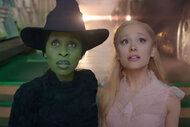Create a free profile to get unlimited access to exclusive videos, sweepstakes, and more!
The Strange Story of John Carpenter and Debra Hill's Plan to Turn Halloween Into an Anthology
The antics of the Silver Shamrock company weren't enough to sell audiences on the anthology idea.

In 1978, John Carpenter and Debra Hill changed the face of horror forever with the release of Halloween. The low-budget thriller about a silent killer stalking and brutally murdering group of teenagers started off as a critical dud, but ultimately netted close to $50 million at the box office and gave birth to the slasher genre. Imitators like Jason Voorhees and Freddy Krueger would, of course, become cinematic icons in their own right, but there's no denying they owe some of their success to the kitchen knife-loving psycho in the bleached William Shatner mask: Michael Myers.
Despite all the sequels that have followed over the decades, the original Halloween works perfectly as a self-contained rumination on the nature of pure evil. And if Carpenter had his way, things would have ended after that fateful night when young Laurie Strode (Jamie Lee Curtis) lost her friends — and innocence — to Michael's bloody rampage.
"It worked for what it was," the filmmaker remarked during an interview with Jim Whaley in 1984. "It was supposed to be a rollercoaster ride, it was supposed to be a horror movie that finally scared you. I updated some old haunted house techniques, basically — the old hand that comes out and taps you on the shoulder stuff, and played with audience expectations. I think it just came along at the right time. Had that movie come later or earlier, it might not have worked as well. Lucky timing."
But money talks and when it does, it whispers the same word over and over into the ears of Hollywood bigwigs: Franchise...Franchise...
Carpenter didn't think his breakout hit needed a second movie, but when the studio came knocking with a hefty chunk of change, he relented, signing on to Halloween II (currently streaming on Peacock) as producer and co-writer. Directed by Rick Rosenthal, the 1981 film picked up directly after the events of the first movie and introduced the Michael-Myers-and-Laurie-Strode-are-siblings twist (a narrative development fueled by a combination of writer's block and booze) that would come to define the majority of subsequent installments. It was less successful than its predecessor, only managing a box office gross of just over $25 million. Carpenter didn't hold back with his thoughts on Halloween II, calling it "an abomination and a horrible movie."
When it came time to make a third installment in the blossoming franchise, Carpenter and Hill had no desire to revisit Michael Myers, whom they considered dead and buried following the explosion at the hospital caused by Samuel Loomis (Donald Pleasance). "The Shape is dead. Pleasence’s character is dead, too, unfortunately," Carpenter stated after the first sequel was released into theaters.
What was to be done with Myers out of the picture? The answer was simple: turn the Halloween brand into a big screen horror anthology "along the lines of Night Gallery or The Twilight Zone, only on a much larger scale, of course," said director Tommy Lee Wallace, who would go on to helm 1982's Halloween III: Season of the Witch (currently streaming on Peacock), which marked Carpenter's final involvement with the series until the 2018 reboot.
"I thought, stupidly — this shows you how dumb I am — I thought that we were done with telling stories about Michael Myers and the guy in the mask. I thought there’s not much more to say," Carpenter told The Hollywood Reporter in 2017. "So we thought we’d come up with a new story every year. We could call it Halloween, but it didn’t have to do anything with Michael Myers."
As such, Carpenter and Hill shifted their focus to themes of paranoia and conformity, with the latter reportedly describing Season of the Witch as "a pod movie" rather than "a knife movie." Featuring a memorably gonzo plot involving supernatural Halloween masks, android assassins, a stolen piece of Stonehenge, and that Silver Shamrock jingle, the third big screen outing flopped both critically and financially, though it's worth noting the title has since been reappraised and gained a cult following.
After two nights in Haddonfield, audiences of the early 1980s were expecting to be reunited with Michael Myers, who briefly shows up in Season of the Witch via a clip from the 1978 film (thus establishing two different cinematic universes).
"The first two Halloweens were successful, but everybody came out of the third saying, 'Where's Michael?'" eventual Halloween producer Paul Freeman told Fangoria Magazine. The decision was made to shift the focus back onto The Shape, who returned to the silver screen six years later in Halloween 4: The Return of Michael Myers — effectively cementing the iconic slasher villain as the indelible cornerstone of the franchise.
Carpenter, on the other hand, stuck by Season of the Witch, which he viewed as a superior movie. "I thought Halloween III was excellent. I really liked that film because it's different [and] it has a real nice feel to it," he said, while praising Wallace as "a talented director."
What would the franchise have looked like if the anthology format had become the rule rather than the exception? Unfortunately, the answer to that question has been lost to time. With that said, many fans posit that the filmmakers probably would have stood a better chance of getting away with the idea if they'd begun telling unrelated tales right off the bat instead of producing a direct sequel. But it's like trying to understand the fractured psyche and swirling malice hidden behind the Shatner mask. We'll never know for certain.
Halloween II and Halloween III: Season of the Witch are currently streaming on Peacock.














